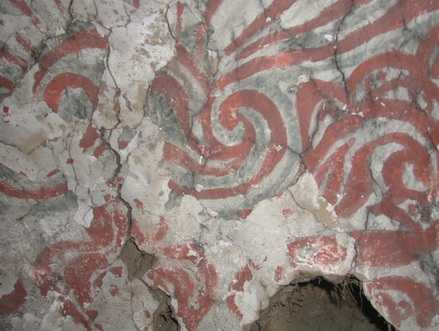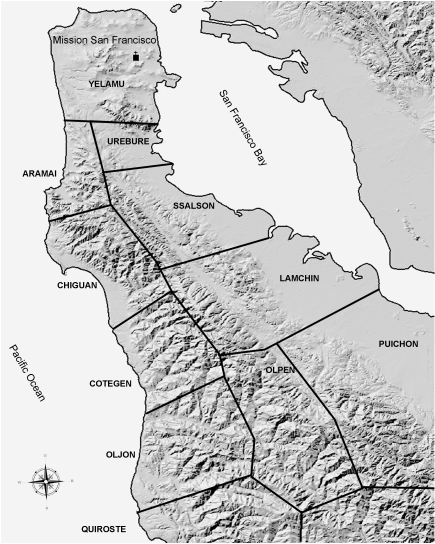Photograph courtesy of Santa Barbara Mission Archive Library, Norman Neuerburg Collection
A history of the mural
|
Behind the wooden altar in the sanctuary at Mission San Francisco de Asís, in San Francisco, is a wall painted in the late eighteenth century. Painted directly onto plaster, in ochre, white, red, yellow, black, and blue/grey, the mural, it is adorned with abstract patterns as well as Christian images, and remains largely under interpreted by scholars.
Besides being an engaging piece of art, the mural is an intriguing artifact from a seemingly remote past. An artifact, which silently stood witness for five years as a few missionaries on the frontier edge of an extended empire, endeavored to convert the numerous native peoples to Catholicism and a Spanish colonial vision of civilization. This mural covers the entirety of the rear wall of the church, behind the historic wooden altar. It measures 21 inches high by 22 feet wide and includes two statuary niches and sits within the back adobe wall only 12 inches behind the wooden altar. A defining factor in the preservation of the mural over the centuries is the mural's situation in a dark, cramped space behind the historic altar. It is quite evident that, while waiting for the altar from Mexico, the mural was painted as a temporary shrine. The construction of adobe walls for the mission church began in 1788 with the manufacture of approximately 36,000 bricks by native laborers. By 1790 the walls were completed, plastered, and whitewashed. It is most likely between this time and the dedication of the church on August 2, 1791 that the mural was painted. Tribal involvementExplore the map to the right for an understanding of the tribal involvement during the period when the mural was painted. This information has been made available by the diligent accounting of the early missionaries and the research of Randall Milliken.
The name of the artist or artists working at Mission Dolores and their history is unknown. San Francisco Bay Natives- represented 95% of the Indian people at the Mission during the period when the mural was most likely painted. In 1790 there were 456 Peninsula (Ramaytush) (86%), 45 East Bay (Chochenyo) (9%), 23 Coast Miwok (5%) and 1 Bay Miwok (>1%) at Dolores.
For more Information+ California’s Hidden Sacred Mural: The History of the Painted Adobe Reredos at Mission Dolores, Ben Wood & Jonathan Cordero, Vol. 57, No. 4 of Journal of the West, 2018 You can purchase the issue here.
+ Mission Dolores by Zephryn Englehardt OFM + A Time of Little Choice by Randall Milliken + Ohlone Past and Present by Lowell Bean + "California Indian Art" by Kurt Baer published in The Americas Vol. 16, No. 1 (Jul., 1959), pp. 23-44 + Norman Neuerburg, The Decoration of the California Missions, Pages 21, 22, 23, 24, 25, 51, 52 + Santa Barbara Mission Archive Library + Historic American Building Survey: HABS CA-113 1936 |
For about five years before the ornate wooden altar covered the mural, friars, soldiers, and native people saw the mural each day. The mural was a bridge between sacred and profane, the visible and the invisible. A baroque-style altar eclipsed around 1796. This mural continues to stand as the backdrop to the mission altar and has been concealed for over 215 years. |

